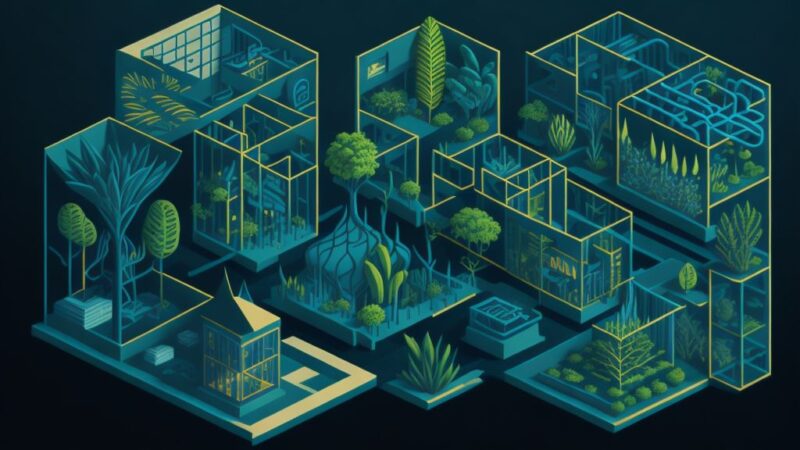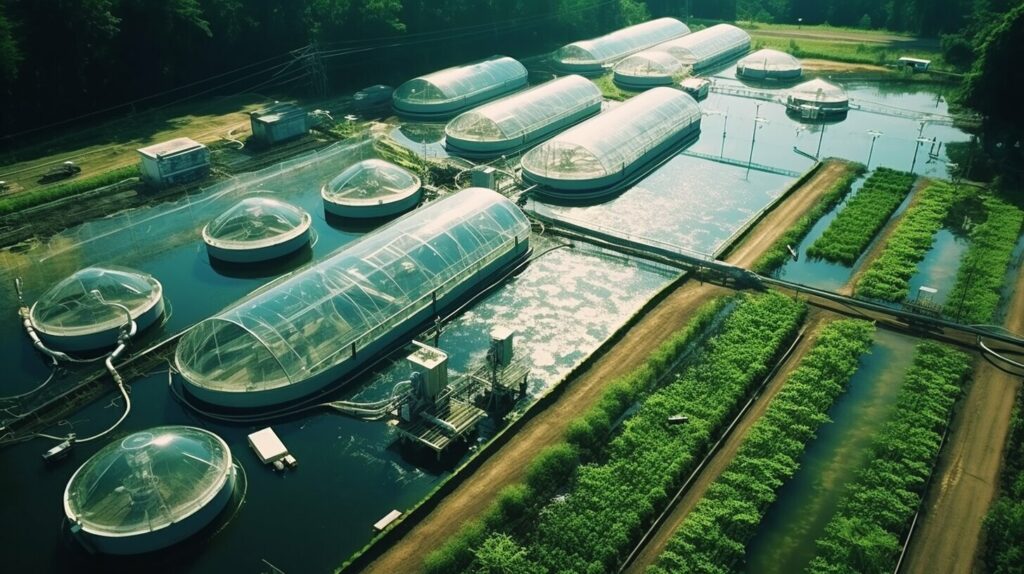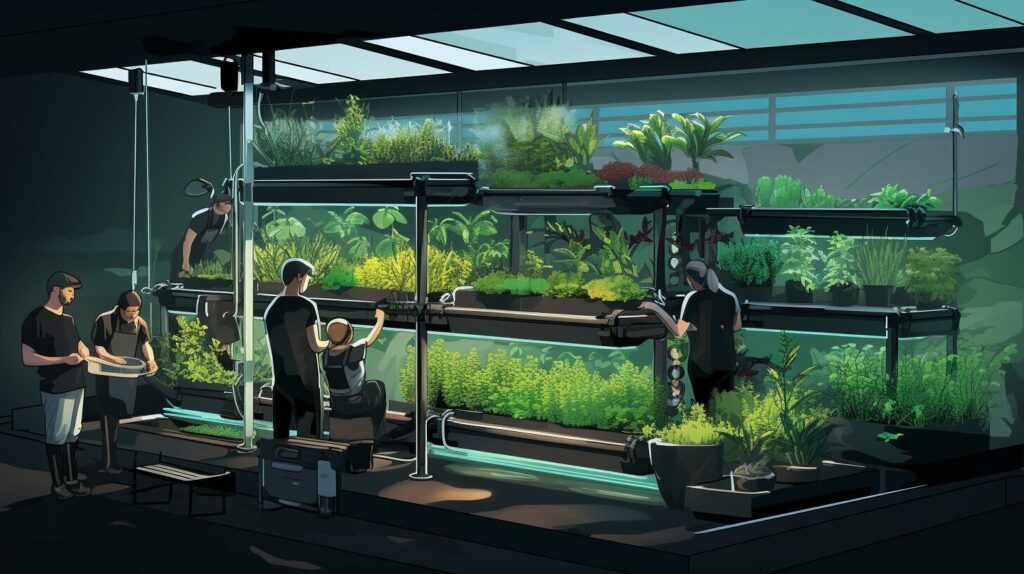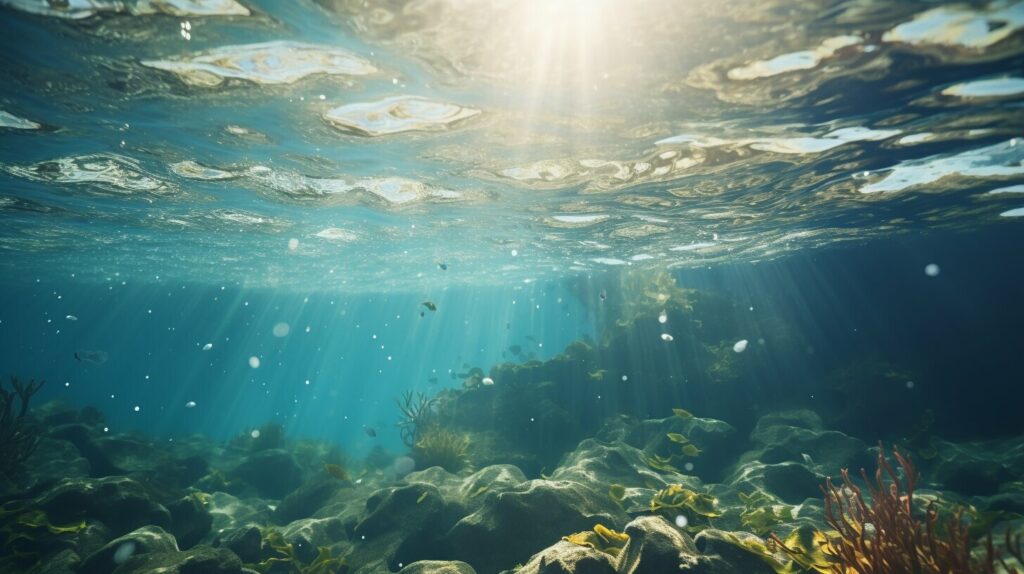This post may contain affiliate links and we may earn a small commission when you click on the links at no additional cost to you. As an Amazon Affiliate, we earn from qualifying purchases. You can read our full disclaimer here.
Are you considering starting an aquaponics system but concerned about the upfront costs? Is aquaponics expensive to start? It’s no secret that setting up any type of farming operation can come with a hefty price tag, but the potential benefits of aquaponics may make it a worthwhile investment. This article will explore whether aquaponics is expensive and what factors can influence the overall cost.
Key Takeaways
- Aquaponics combines fish farming and plant cultivation in a closed-loop system, promoting sustainability and efficient resource use.
- Aquaponics offers year-round production, reduced water and chemical use, and crop and fish selection versatility.
- Depending on scale and complexity, initial expenses for fish tanks, growing beds, and equipment range from a few thousand to tens of thousands.
- Labor expenses vary with operation size and complexity; automation can reduce costs.
- System size and complexity affect costs; larger or more complex setups require more resources.
- A well-planned business strategy is essential to assess initial costs and potential profitability.
- While initial costs may be higher, aquaponics can offer long-term benefits through reduced chemical use and sustainability.
- Expanding your aquaponics farm increases income but comes with additional expenses; resource availability and ongoing costs should be considered.
- Starting an aquaponics system varies in cost, but its sustainability and profitability potential make it a viable farming option with careful planning.
Understanding Aquaponics and Aquaponic Systems

If you’re considering starting an aquaponic system, it’s important to understand what aquaponics is and how it works. Aquaponics is a sustainable farming method combining aquaculture (fish farming) and hydroponics (growing plants in water). The fish and plants are grown together in a closed-loop system, where the waste produced by the fish is used as fertilizer for the plants, and the plants, in turn, help to filter and clean the water for the fish.
An aquaponic system typically consists of several key components, including a fish tank, a growing bed or beds, a water pump, and a means of filtration. The fish are raised in the tank, and their waste is pumped to the growing bed, filled with a growing medium like gravel or clay pellets. The plants can then absorb the nutrients from the fish waste, and the cleaned water is returned to the fish tank. The system is designed to be highly efficient and low-waste, with minimal water usage and no need for chemical fertilizers or pesticides.
Advantages of Aquaponics
One of the main advantages of aquaponics is its potential for year-round production, as the system can be operated indoors with proper lighting and temperature control. Additionally, it can be a highly sustainable farming method, as it uses significantly less water and eliminates the need for synthetic fertilizers and pesticides. Aquaponic systems are also highly scalable and versatile, able to grow various crops and fish species.
Now that you have a basic understanding of how aquaponics works let’s dive into the startup costs of getting your aquaponic system up and running.
Startup Costs for Aquaponics

Starting an aquaponic system requires a significant initial investment in equipment, materials, and infrastructure. The startup costs can vary depending on the operation’s scale, the farm’s size, and whether it is intended for commercial or small-scale use.
Some of the key components that you will need to consider when estimating the startup cost of an aquaponics system include:
Fish Tanks
The fish tank is a crucial component of the aquaponic system, and its estimated cost will depend on its size and material. A high-quality commercial-grade tank can cost a few thousand dollars, while a smaller, more affordable tank can be purchased for a few hundred dollars.
Growing Beds
Your growing beds must be filled with a growing medium, such as gravel, to support the plants. The total cost of the growing medium will depend on the size of your growing bed and the type of materials used. The growing bed can be made from various materials, including wood, plastic, or concrete, and the cost will vary accordingly.
Greenhouse Structures
A greenhouse is necessary for an aquaponic system to provide a controlled environment for the plants and fish. A greenhouse can range from a few hundred dollars for a small DIY structure to several thousand dollars for a commercial-grade unit.
Other Equipment and Materials
In addition to the major components, there are other equipment and materials that you will need to purchase, including pumps, filters, plumbing, lighting, and electrical systems. The cost of these items will depend on the size and complexity of your aquaponic system.
Consider the cost of these factors and budget accordingly when estimating the startup cost of your aquaponics system. The average cost to start a small-scale aquaponics operation can cost around a few thousand dollars to tens of thousands. However, depending on the size and complexity of your operation, the cost may be higher.
| Component | Description |
|---|---|
| Fish Tanks | Size and material-dependent (commercial-grade) |
| Growing Beds | Growing medium and materials-dependent |
| Greenhouse Structures | Size and complexity-dependent |
| Other Equipment | Pumps, filters, plumbing, lighting, electrical |
| Miscellaneous Costs | Permits, water source, seeds, fish, labor, etc. |
Labor Costs in Aquaponics Farming
Running an aquaponics operation involves various tasks, from feeding and monitoring the fish to maintaining the water quality and harvesting your crops. Depending on the scale of your aquaponics farm, you may need to hire additional staff to handle these responsibilities.
The labor cost can vary significantly depending on the size of your operation and the level of expertise required. For small-scale aquaponics setups, you may be able to handle most of the work on your own or with the help of a few part-time workers. However, you may need to hire full-time employees with specific skills or training for larger commercial operations.
When budgeting for labor costs, it’s important to consider wages, benefits, and other expenses like training and insurance. You’ll also need to factor in the time and effort required for recruiting, hiring, and managing your staff.
Fortunately, there are ways to reduce labor costs in aquaponics farming, such as automating certain tasks or using technology to monitor water quality and other variables. Streamlining your operation and finding efficient ways to manage your resources can minimize labor expenses and increase your overall profitability.
Aquaponics Setup and Its Impact on Costs
The scale and complexity of your aquaponics setup may significantly impact your overall costs.
For small-scale aquaponics operations, a simple setup using a few fish tanks and growing beds may be sufficient. However, larger commercial aquaponics farms may require more elaborate infrastructure, such as multiple tanks, elaborate pump systems, and climate-controlled greenhouse structures.
System Size
The bigger your aquaponics farm, the more you can expect to pay for your setup. Larger systems require more materials, equipment, and labor to install and maintain. For example, a small-scale aquaponic setup might only require a few hundred gallons of water, while a commercial aquaponics operation could require tens of thousands of gallons. The larger the system, the more you can expect to pay for pumps, filters, and other components.
System Complexity
The complexity of your aquaponic system may also influence your costs. For example, some aquaponics setups may require automated monitoring and control systems to maintain optimal conditions for both fish and plants. These systems can be expensive to install, maintain, and repair. In contrast, a simpler system that relies on manual labor may be more affordable regarding setup costs.
Ultimately, the cost of your aquaponics setup will depend on various factors. By understanding the different options available and how they impact your costs, you can make an informed decision about the best setup for your needs.
Analyzing the Return on Investment in Aquaponics

Before starting an aquaponics business, it’s important to consider the investment cost and potential return on investment. Starting an aquaponic farm is a significant financial undertaking, but the rewards can be impressive. Aquaponics is a growing industry for small business owners in the United States.
When starting any business, it’s important to have a thorough business plan in place. This plan should include the initial investment cost, projected revenue, and profits. With an aquaponics business, you must account for the cost of equipment, building materials, fish and plant stock, and any necessary permits or licenses.
The good news is that aquaponics can be a profitable venture, especially for small-scale operations. The costs may vary depending on the operation’s scale and the farm’s location.
Starting an aquaponic business is a good idea for small business owners in the US. It is a sustainable business that can provide fresh produce and fish to local markets. Investing in aquaponics can also result in a positive impact on the environment and local communities.
Researching the aquaponics industry and market is important before starting a business. You should identify the potential customers and their needs. By understanding the market, you can develop a plan and strategy for your aquaponic operation that can help ensure success.
Investing in an aquaponics farm can be an excellent opportunity for small business owners in the US. With the right planning, you can minimize the investment cost while maximizing the potential return.
Comparing Aquaponics Costs with Traditional Farming Methods
While aquaponics may seem like a significant initial investment, it’s vital to compare it to traditional farming methods like hydroponics to understand the long-term value of aquaponics.
Initial Cost
The initial cost of an aquaponics system may be higher than that of hydroponics. However, the cost depends on the scale of the operation and the level of complexity of the aquaponics setup. A small-scale aquaponics system may require less initial cost than a hydroponic setup with a larger scale.
System Requires
Hydroponic farming requires a nutrient solution that can be costly and complicated to manage. In contrast, aquaponics uses fish waste as a natural fertilizer, reducing the need for costly chemicals. With an aquaponics system, you can cultivate fish and plants simultaneously, leading to higher yields and more significant profits.
Furthermore, aquaponics is a sustainable and environmentally friendly method of agriculture, making it an investment in the future. While it may have a higher initial investment, it can often have a better return on investment in the long run.
Scaling and Expansion of Aquaponics Farms
Expanding your aquaponics farm can be a significant investment, but the benefits can be substantial. The scale of your operation will determine the costs associated with expansion and the considerations involved. If you plan to scale up, you will need to assess the needs of your aquaponics farm. Consider important factors such as the number of fish tanks and growing beds required, the space needed to accommodate them, and the staff necessary to manage your expanded operations.
The cost of building your aquaponics farm will increase with expansion, so you must factor these expenses into your budget. You must also consider ongoing expenses such as water, electricity, and labor costs. Another consideration when scaling your aquaponics farm is the availability of resources. For instance, larger operations require more water and electricity than smaller ones.
Depending on your location and the current market prices of fish and plants, you may incur additional expenses in managing your aquaponics operation. Expanding your aquaponics farm can help you generate more income. The larger scale of your operation will allow for increased production, translating into more products for sale. However, scaling your aquaponics farm can also lead to additional expenses, so it is important to consider the financial implications before making any decisions.
Conclusion: So, is Aquaponics Expensive to Start?
The answer, as with many things, is that it depends. Numerous factors can influence the cost of starting an aquaponics system, from the size and scale of the operation to the complexity of the setup and ongoing maintenance and operation expenses.
However, despite the potentially significant initial investment required, there are also many benefits to pursuing aquaponics as a sustainable farming method. It offers the potential for combining plant and fish cultivation, using less water and pesticides than traditional farming methods, and generating higher yields per unit of land than conventional farming.
If you’re considering starting an aquaponics farm, carefully evaluating your costs and potential return on investment is important. Consider factors like location, market prices, ongoing maintenance expenses, and the scalability of your operation.
While aquaponics may require a higher initial investment than traditional farming methods, it also offers the potential for a sustainable and profitable small business in the United States. So if you’re up for the challenge, why not try?




Pingback: Criteria for Effective Plant Selection in Aquaponics - Aquaponics Daily